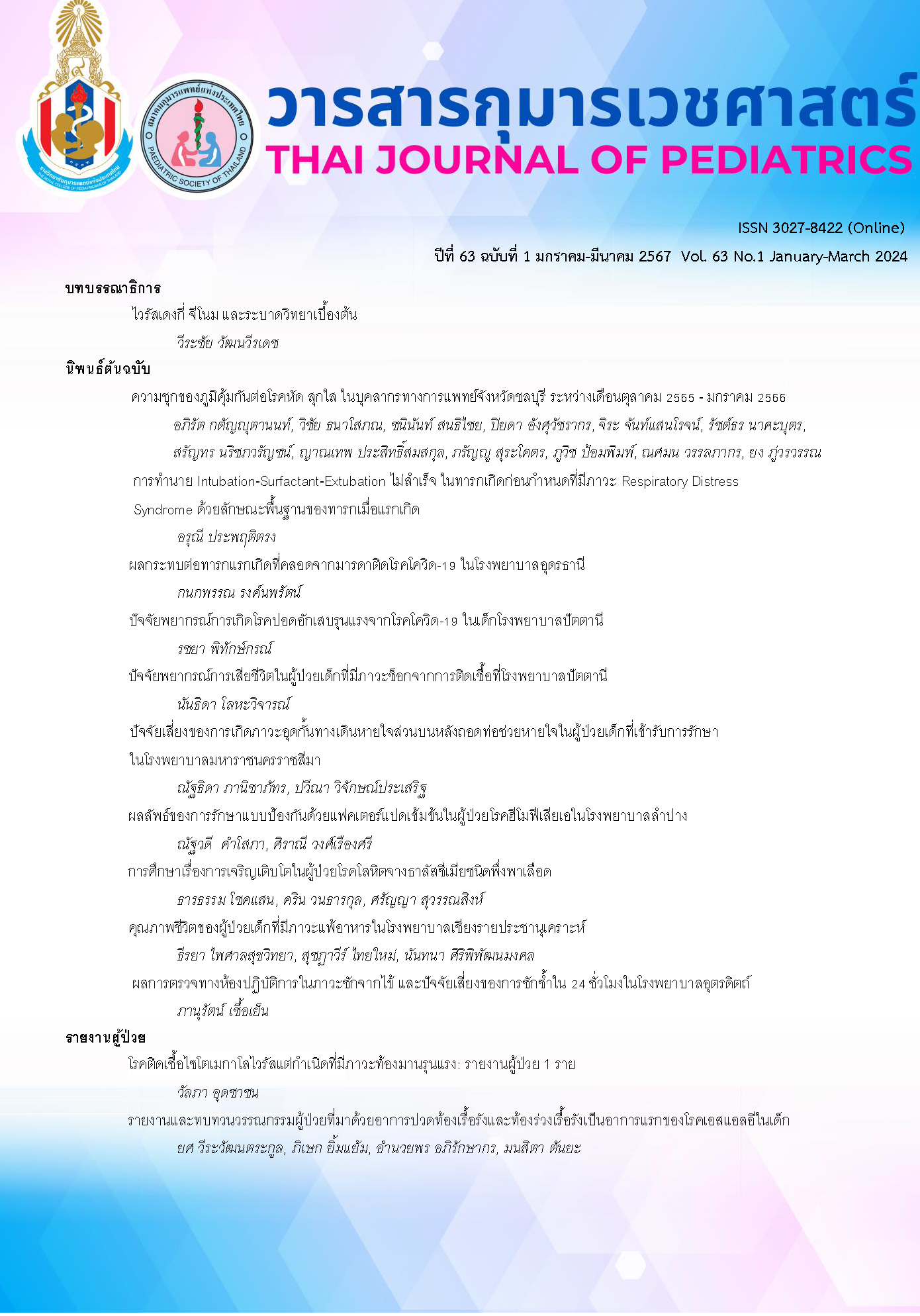การทำนาย Intubation-Surfactant-Extubationไม่สำเร็จ ในทารกเกิดก่อนกำหนด ที่มีภาวะ Respiratory Distress Syndrome ด้วยลักษณะพื้นฐานของทารกเมื่อแรกเกิด
คำสำคัญ:
การถอดท่อช่วยหายใจ , การพยากรณ์โรค , กลุ่มอาการหายใจลำบาก , สารลดแรงตึงผิว , อายุครรภ์ , น้ำหนักแรกเกิด , คะแนน Apgarบทคัดย่อ
ความเป็นมา: การรักษาโรค respiratory distress syndrome (RDS) ในทารกเกิดก่อนกำหนด ด้วย surfactant โดยวิธี INSURE (INtubation-SURfactant-Extubation) มีการใช้อย่างแพร่หลาย เพื่อลดภาวะแทรกซ้อนจากการใช้เครื่องช่วยหายใจแบบรุกราน ซึ่งพบว่าหาก INSURE ไม่สำเร็จ คือใส่ท่อช่วยหายใจซ้ำภายในเวลา 72 ชั่วโมงหลังถอด อัตราการเสียชีวิต ภาวะปอดอักเสบเรื้อรังจะเพิ่มมากขึ้น
วัตถุประสงค์: เพื่อสร้างคะแนนทำนายโอกาส INSURE ไม่สำเร็จ โดยใช้ลักษณะพื้นฐานของทารกแรกเกิด
รูปแบบ สถานที่ และผู้ป่วย: เป็นการศึกษาแบบ prognostic prediction research รูปแบบ retrospective observational design ในช่วง 1 มกราคม พ.ศ. 2561 ถึง 31 ธันวาคม พ.ศ. 2565 ในทารกเกิดก่อนกำหนด อายุครรภ์น้อยกว่าหรือเท่ากับ 34 สัปดาห์ ที่มีภาวะ RDS ที่ได้รับการรักษาด้วยวิธี INSURE ของโรงพยาบาลพัทลุงหากมีการใส่ท่อช่วยหายใจใหม่หลังจากถอดภายใน 72 ชั่วโมง ถือว่า INSURE ไม่สำเร็จ
วิธีการศึกษา: ศึกษาข้อมูลย้อนหลังจากเวชระเบียน ลักษณะพื้นฐานของทารกและมารดา ที่มีผลต่อ INSURE ไม่สำเร็จ สร้างชุดทำนาย INSURE ไม่สำเร็จ ด้วย multivariable logistic regression โดยกำหนดคะแนนความเสี่ยงจากค่า coefficient ของตัวแปรในสมการ
ผลการศึกษา: ผู้ป่วยที่ศึกษา 159 ราย ติดตามจนจำหน่าย มีผู้ป่วยที่รักษาด้วย INSURE ไม่สำเร็จ 26 คน (ร้อยละ 16.4) ลักษณะที่ทำนาย INSURE ไม่สำเร็จมี 4 ตัวแปร คือ 1. อายุครรภ์ของมารดา 2. น้ำหนักตัวแรกเกิดของทารก 3. คะแนน APGARs ที่ 1 นาที และ 4. ความรุนแรงของ RDS ทารกที่มีคะแนนสูง (มากกว่า 16) เพิ่มความเสี่ยง 6 เท่า ในภาพรวม คะแนนที่ >16 มีค่าความไว (sensitivity) ร้อยละ 80.8, ความจำเพาะ (specificity) ร้อยละ 87.2 และ AuROC 0.86, 95%CI (0.77-0.96)
สรุป: การสร้างคะแนนที่ทำนาย INSURE ไม่สำเร็จ มีความสำคัญในการช่วยระบุความเสี่ยงที่เกี่ยวข้องกับการรักษาโรค RDS ในทารกเกิดก่อนกำหนดด้วยวิธี INSURE คะแนนทำนายช่วยให้ทีมแพทย์สามารถเลือกใช้วิธีการรักษาที่เหมาะสมที่สุดสำหรับทารกแต่ละราย
Downloads
เอกสารอ้างอิง
Sweet DG, Carnielli VP, Greisen G, Hallman M, Klebermass-Schrehof K, Ozek E, et al. European consensus guidelines on the management of respiratory distress dyndrome: 2022 update. Neonatology. 2023;120:3-23.
Naseh A, Yekta BG. INSURE method (intubation surfactant extubation) in early and late premature neonates with respiratory distress: factors affecting the outcome and survival rate. Turk J Pediatr. 2014;56:232-7.
Nayeri FS, Esmaeilnia Shirvani T, Aminnezhad M, Amini E, Dalili H, Moghimpour Bijani F. Comparison of INSURE method with conventional mechanical ventilation after surfactant administration in preterm infants with respiratory distress syndrome: therapeutic challenge. Acta Med Iran. 2014;52:596-600.
Najafian B, Saburi A, Fakhraei SH, Afjeh A, Eghbal F, Noroozian R. Predicting factor of INSURE failure in low birth weight neonates with RDS. Iran J Neonatol. 2015;5:30-4.
Mandhari HA, Al Riyami B, Khan A, Nonoyama M, Rizvi SGA. Risk factors of extubation failure in intubated preterm infants at a tertiary care hospital in Oman. Sultan Qaboos Univ Med J. 2022;22:247-52.
Brix N, Sellmer A, Jensen MS, Pedersen LV, Henriksen TB. Predictors for an unsuccessful intubation surfactant extubation procedure: A cohort study. BMC Pediatr. 2014;14:155.
Cherif A, Hachani C, Khrouf N. Risk factors of the failure of surfactant treatment by transient intubation during nasal continuous positive airway pressure in preterm infants. Am J Perinatol. 2008;25:647-52.
Dani C, Corsini I, Bertini G, Fontanelli G, Pratesi S, Rubaltelli FF. The INSURE method in preterm infants of less than 30 weeks' gestation. J Matern Fetal Neonatal Med. 2010;23:1024-29.
Ognean ML, Stoicescu SM, Boanta O, Nastase L, Gliga C, Cucerea M. Intubation surfactant: extubation on continuous positive pressure ventilation. J Crit Care Med. 2016;2:73-9.
Park SJ, Bae MH, Jeong MH, Jeong SH, Lee N, Byun SY, et al. Risk factors and clinical outcomes of extubation failure in very early preterm infants. BMC Pediatr. 2023;23:36.
Li T, Jiang H, Liu DY, Li XH. Risk factors for the failure of the INSURE method in very preterm infants with respiratory distress syndrome. Zhongguo Dang Dai Er Ke Za Zhi. 2014;16:610-3.
De Bisschop B, Derriks F, Cools F. Early predictors for Intubation surfactant extubation failure in preterm infants with neonatal respiratory distress syndrome: A systematic review. Neonatology. 2020;117:33-45.
Dani C, Corsini I, Poggi C. Risk factors for intubation surfactant extubation (INSURE) failure and multiple INSURE strategy in preterm infants. Early Hum Dev. 2012;88:S3-4.
Azzabi O, Selmi I, Bellali H, Siala N, Dridi Y, Fetni I, et al. Intubation surfactant extubation Strategy in a medical resource-limited department: A prospective study. J Trop Pediatr. 2016;62:169-70.
Ancora G, Maranella E, Grandi S, Pierantoni L, Guglielmi M, Faldella G. Role of bilevel positive airway pressure in the management of preterm newborns who have received surfactant. Acta Paediatr. 2010;99:1807-11.
He F, Wu D, Sun Y, Lin Y, Wen X, Cheng ASK. Predictors of extubation outcomes among extremely and very preterm infants: a retrospective cohort study. J Pediatr. 2022;98:648-54.
Koons A, Hegyi T, Mehta R, Hiatt M, Weinberger B. Cerebral vascular responses to changes in carbon dioxide tension in term and preterm infants with apnea. Biol Neonate. 2003;84:115-8.
Derrick M, Luo NL, Bregman JC, Jilling T, Ji X, Fisher K, et al. Preterm fetal hypoxia-ischemia causes hypertonia and motor deficits in the neonatal rabbit: A model for human cerebral palsy? J Neurosci. 2004;24:24-34.
Fuchs H, Lindner W, Leiprecht A, Mendler MR, Hummler HD. Predictors of early nasal CPAP failure and effects of various intubation criteria on the rate of mechanical ventilation in preterm infants of <29 weeks gestational age. Arch Dis Child Fetal Neonatal Ed. 2011;96:343-7.
Cheng Z, Dong Z, Zhao Q, Zhang J, Han S, Gong J, et al. A prediction model of extubation failure risk in preterm infants. Front Pediatr. 2021;9:693320.
ดาวน์โหลด
เผยแพร่แล้ว
รูปแบบการอ้างอิง
ฉบับ
ประเภทบทความ
สัญญาอนุญาต
ลิขสิทธิ์ (c) 2024 ราชวิทยาลัยกุมารแพทย์แห่งประเทศไทย และ สมาคมกุมารแพทย์แห่งประเทศไทย

อนุญาตภายใต้เงื่อนไข Creative Commons Attribution-NonCommercial-NoDerivatives 4.0 International License.



